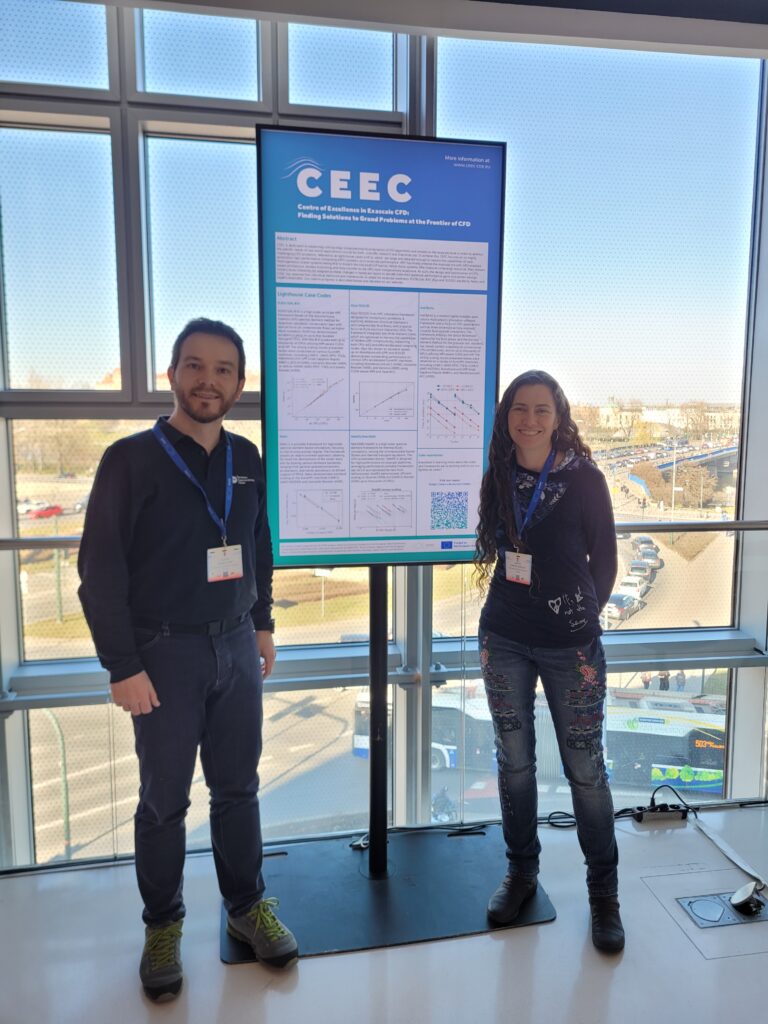
We ahad the pleasure of joining over 30 other EuroHPC Joint Undertaking funded projects developing skills, codes, technologies, and even international cooperation in the poster showcase at last week’s #EuroHPCSummit2025 in Krakow, Poland. As we enter the second half of our project runtime, we chose to showcase the scaling results of our codes so far. If you missed the poster showcase, you can check it out below along with extra details of the lighthouse cases (LHCs) for which each code is being developed.
The Lighthouse Cases
Shock Boundary Buffet – FLEXI/GALÆXI
Modern transport aircraft cruise at transonic flight conditions, where the local acceleration over the suction side of the wing leads to localized supersonic flow. These supersonic pockets are terminated by normal shock waves, i.e., confined and highly localized regions in the flow where all flow quantities undergo drastic changes – the flow becomes ‘shocked’. The strength of these shocks increases with flight Mach number and angle of attack and the associated pressure gradients can trigger flow separation and thus loss of lift. Under certain conditions near the edge of the flight envelope, a complex interaction between the separated flow field passing over the trailing edge of the wing and the shock itself can occur, which leads to a low frequency, high amplitude periodic oscillation of the shock position. This self-sustaining feedback mechanism is called a shock buffet. It not only leads to high dynamic loads on the wings, a highly unsteady wing wake, and a rough flight but increased structural fatigue of the wing in the long run. Thus, understanding and reliably predicting such phenomena is of utmost importance for flight safety, efficiency, and radical new aircraft design concepts. To improve understanding, the open-source framework FLEXI/GALÆXI is used to investigate the effect of 3D shock buffet on a transonic airfoil. FLEXI/GALÆXI is a high-order accurate HPC framework based on the discontinuous Galerkin (DG) spectral element method for hyperbolic-parabolic conservation laws with special focus on compressible flows. FLEXI has demonstrated excellent scaling on up to five hundred thousand CPUs, and GALÆXI scales well up to thousands of GPUs utilizing MPI-aware CUDA and HIP. The strong scaling results presented below were conducted on various EuroHPC machines, including LUMI-C (AMD EPYC 7763), MareNostrum5 GPP (Intel Sapphire Rapids 8480+), JEDI (GH200), Leonardo Booster (A100), as well as HAWK (AMD EPYC 7742) and Juwels Booster (A100).
High Fidelity Aeroelastic Simulation – Alya/SOD2D
Wind tunnel simulations are usually stiff and therefore avoid elastic deformations of the structure and their associated aeroelastic effects. However, aeroelastic effects on the aircraft wing may appear for specific flight conditions, e.g., cruise at transonic speed, and tend to be a more complex phenomenon to be solved numerically. Thus, multi-physics simulations of the wing structure and the flow field are necessary to generate realistic and accurate solutions for the certification of the structure. The lack of computational methods to solve this kind of problem together with the elevated computational cost of the coupled problem, this type of simulation may be impractical without the use of high-performance computing (HPC). To address existing methodology gaps in the coupling of advanced LES models with structural dynamic, an aeroelastic simulation of the SFB 401 wing, also known as the HIRENASD wing model, in a transonic regime will be conducted using existing large-eddy simulations models for compressible flows and the multi-physics framework Alya/SOD2D. Alya/SOD2D is an HPC simulation framework designed for multiphysics problems. It explicitly addresses structural mechanics and compressible fluid flows, with a special focus on fluid-structure interaction (FSI). The framework integrates two finite element codes which are optimized to harness the capabilities of modern HPC infrastructures, supporting both CPU-only and GPU-accelerated computing nodes. Alya is a modular and flexible continuous Galerkin finite element code for multiphysics problems, while SOD2D is a CFD code designed to solve simulations of both turbulent compressible and incompressible flows using the continuous Galerkin high-order spectral element method, minimizing numerical dissipation by removing the need for flux reconstruction between elements. Alya has shown an excellent speed-up on MareNostrum5-GPP, and SOD2D demonstrates outstanding performance on various GPU-accelerated EuroHPC machines, including MareNostrum5-ACC (H100), Leonardo Booster (A100), and Karolina (A100) using CUDA-aware MPI and OpenACC.
Topology Optimization – Neko
Static mixers have been in use since the 1970s for blending fluids in a wide range of applications ranging across waste-water treatment, food processing, pharmaceutical, and chemical applications. Essentially, a static mixer is a part of a pipe in which the incoming fluid streams are mixed by the deflection effect of the internal geometry, with the goal of achieving the highest mixing with the least pressure drop. A static mixer is a passive device without any moving parts. Static mixers are thus very reliable with low maintenance needs and typically low production costs. To optimize static mixers, a profound understanding of the fluid mechanics is necessary. Here, topology optimization, based on a mathematical formulation of the respective objective functions, will be implemented in the high-order framework Neko to obtain novel mixer designs, where the fluid mechanical aspects of the problem are fully resolved. This will mark the first demonstration of topology optimization of turbulent static mixers in complex flow situations. It will advance the current state-of-the-art on various levels: algorithmically for large-scale optimization, mathematically for developing ways to treat a chaotic system, and computationally to perform large-scale 3D optimization.
Localized Erosion – waLBerla
Suction bucket foundations are a cost-efficient and environmentally friendly way to install offshore wind turbines by applying suction pressure inside the bucket until it is fully embedded in the soil. Unfortunately, this installation process can have a significant risk of erosive failure if the operating suction exceeds a critical threshold. However, the complex physical phenomena underlying the erosive failure are not sufficiently understood yet. To improve the understanding, a three-dimensional fully-resolved coupled fluid-particle simulation is implemented in the high-performance computing multiphysics open source framework waLBerla, aiming to enhance understanding and develop preventive strategies for erosive failure. waLBerla is a modern highly scalable open source multi-physics simulation software framework with a focus on CFD applications such as three-dimensional fully-resolved coupled fluid-particle simulations. The framework employs the lattice Boltzmann method for the fluid phase, and the discrete element method for the granular soil. Simulating physically relevant problem sizes – comprising hundreds of thousands of grains, each fully resolved with fluid cells – requires extensive computational resources on modern supercomputers. waLBerla has shown prefect scalability on conventional CPU architectures, and on up to thousands of GPUs utilizing MPI-aware CUDA and HIP. The strong scaling results presented below were obtained on a variety of EuroHPC machines, including LUMI-C (AMD EPYC 7763), LUMI-G (AMD MI250X), MareNostrum5-GPP (Intel Sapphire Rapids 8480+), and MareNostrum5-ACC (H100).
Atmospheric Boundary Layer flows – Nek5000/NekRS
Atmospheric boundary layer (ABL) flows, in addition to their role in vertical exchanges of moisture and aerosols in the atmosphere, also affect transportation, power generation from renewable sources (wind and solar), pollutant dispersion, and others. As such, efficient and reliable simulation of ABL flows is important for the study of wind farms, urban canyons, and basic weather modeling. However, density stratification from surface heating and cooling directly affects the highly turbulent flows, with Coriolis effects caused by the earth’s rotation complicating them even further. Regional weather patterns and terrain morphology add additional complexity to ABL flows. Here, high-performance computing has the potential to alter the landscape of turbulence simulations in the ABL as with increased computer power large-eddy simulations (LES) of ABLs, coupling small and large scales in realistic environments will be permitted. To advance the state of the art in terms of algorithms for exascale simulations of ABL flows and in turn the understanding of ABL flows, the simulation framework Nek5000/NekRS is used. Nek5000/NekRS is a high-order spectral element framework for thermal-fluids simulations, solving the incompressible Navier-Stokes and thermal transport equations. The GPU-accelerated version NekRS is designed for high-performance on exascale platforms, leveraging performance-portable frameworks like OCCA and optimized kernels from libParanumal. The framework employs a semi-implicit time integration scheme to efficiently solve elliptic subproblems for pressure and velocity components. The high-order spectral element method enables precise resolution of fine-scale turbulence in atmospheric boundary layer flows while preserving computational efficiency. NekRS demonstrates efficient scaling on Summit (V100) and JUWELS Booster (A100) up to thousands of GPUs.
Merchant Ship Hull – Neko
A rapid shift towards more environment-friendly propulsion systems is a high priority for all branches of the transport sector. This includes the marine shipping industry, which currently accounts for approximately 90% of all freight transport. A critical component of evaluating the performance of a ship hull design is the accurate prediction of the associated flow structures forming near the hull’s surface and in its wake. This concerns both the prediction of the friction drag, but also the performance of the propulsion system, particularly the propeller and potential energy saving devices. Both are located in the turbulent wake formed behind the hull of the vessel and are subject to associated unsteady loads. Low-fidelity turbulence modelling approaches are not capable of properly resolving the large vortical structures forming on the hull and directly affecting the flow in the wake. To advance the understanding of these large vortical structures and to provide valuable reference data, scale-resolving turbulence modeling methods are used to compute the flow around the Japan Bulk Carrier (JBC), which was studied extensively at the Workshop on CFD in Ship Hydrodynamics in Tokyo, 2015. Neko will be used to perform these simulations, leveraging its high-order accuracy, computational efficiency, and portability across computing hardware. Neko is a portable framework for high-order spectral element-based simulations, focusing on the incompressible regime. The framework adopts an object-oriented approach, allowing for multi-tier abstractions of the solver stack and facilitating various hardware backends, ranging from general-purpose processors, accelerators, and vector processors, to limited support of FPGAs. Neko demonstrates excellent scaling on various EuroHPC machines such as LUMI-G (AMD MI250X) and Leonardo Booster (A100).
